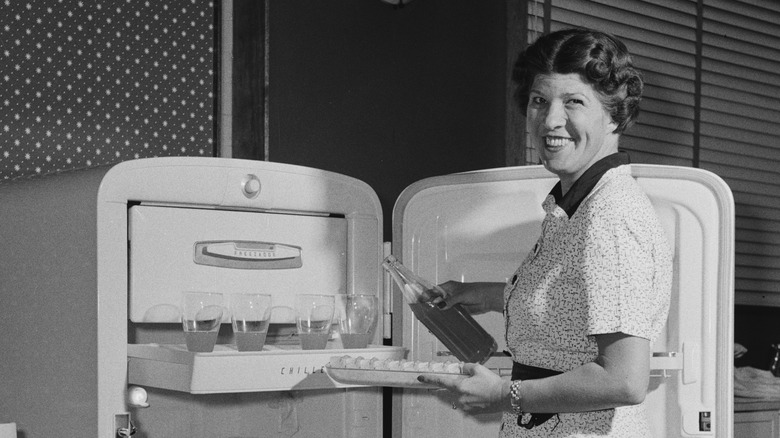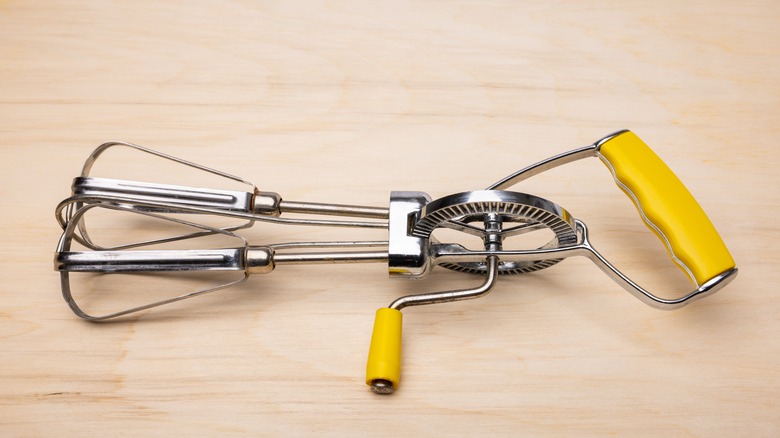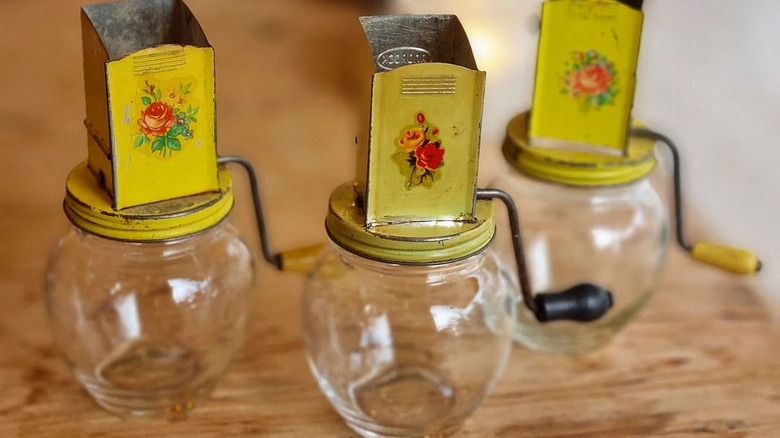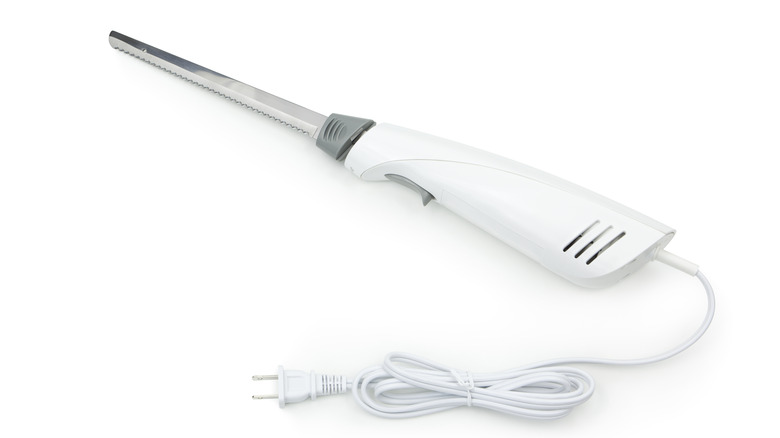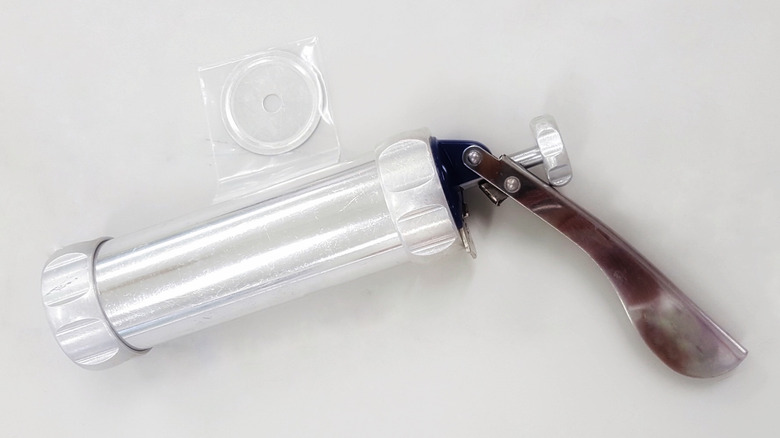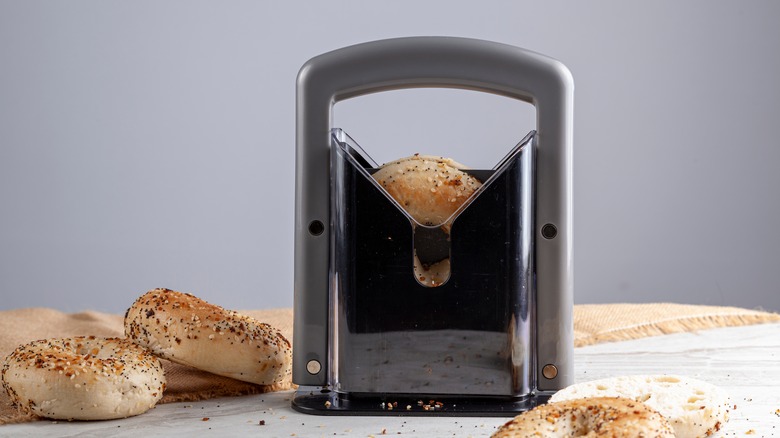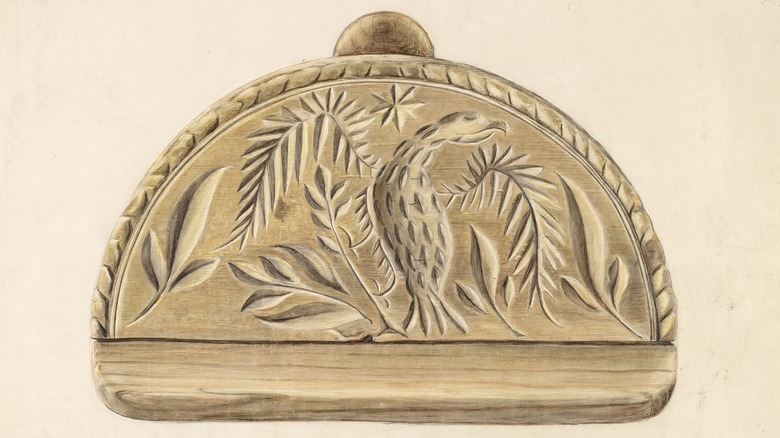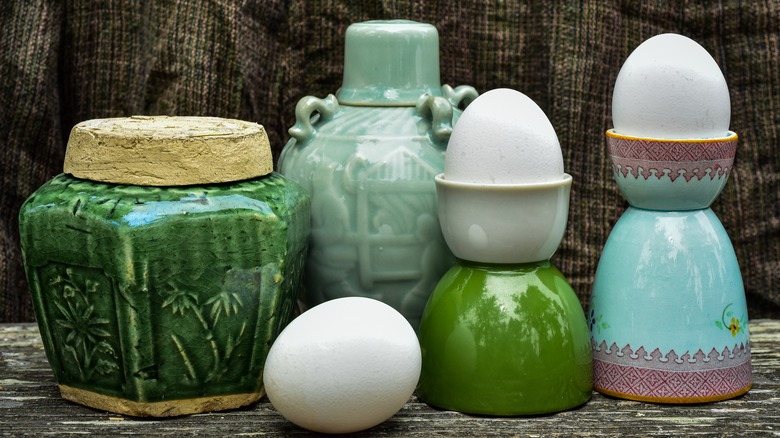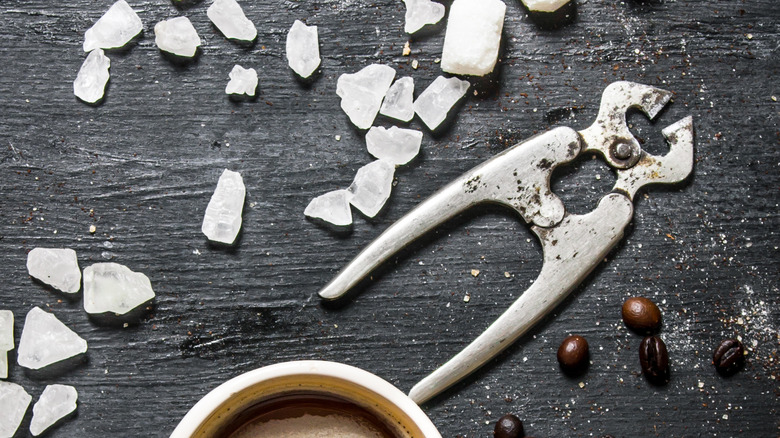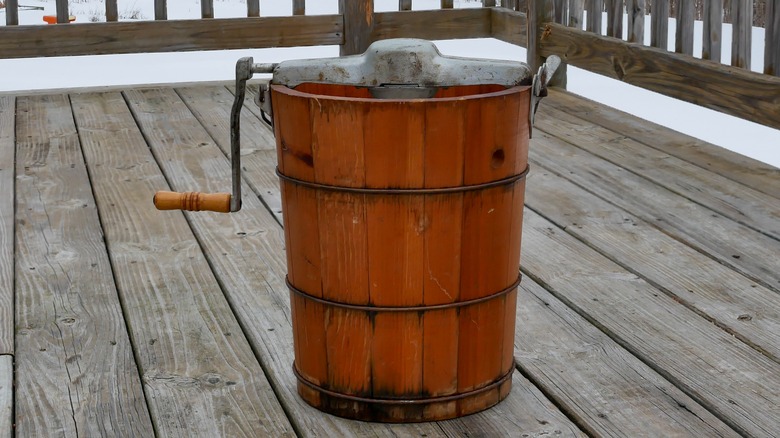Once-Popular Kitchen Tools People Stopped Using
When it comes to cooking, there's no shortage of ways to do things easier, better, and faster. No wonder American kitchens then have been home to so many quirky gadgets and appliances. Some of these tools — like your fridge, blender, toaster, air fryer, and can opener — have become kitchen essentials. Others? Well, they're lining the shelves at your local Goodwill, filling up Facebook Marketplace and eBay, and some have even earned a slot in museums for their uniqueness.
Take a minute to ponder all the kitchen tools that have come and gone over the years, even in your lifetime. Back in the day, milk separators were a kitchen must-have, required to help separate cream from milk after some lucky member of your household would have just finished morning milking. We needed butter churns, nutcrackers, meat hammers, and even ice picks just to store and prep ingredients for the day's meal. More recently, your kitchen — or the kitchen you grew up in — might have been home to then "trendy" gadgets like a salad shooter, egg "cuber," hot dog cooker, tomato shark, or even the infomercial-famous microwaveable bacon rack (perfect for cooking crispy bacon minus the fat).
And that's just the tip of the icebox, so to speak. While those gadgets and appliances were popular in some homes, they weren't as ubiquitous as the stuff that follows. Keep reading as we head down memory lane and look at some of the once-popular kitchen tools that modern cooks have essentially stopped using.
Crank egg beater
For many a child, mom's (or grandma's) egg beaters were a tempting toy to play with — but also an incredibly easy way to pinch tiny fingers. This hand-cranked device, also known as a hand mixer or rotary egg beater, was initially designed for mixing together a variety of wet and dry ingredients. A typical egg beater consists of a handle attached to a gear mechanism that rotates one or more beaters or whisk attachments. Inventor Willis Johnson of Cincinnati, Ohio patented the first ever variation of egg beater (which he built by hand) in the early part of 1884. His device even contained two different chambers for mixing — when one side was dirty, you had another side you could use.
As the mixer Willis created gained popularity, and other versions joined the market, home cooks began to use these beaters primarily for beating eggs. They were ideal for introducing air and fluffy lightness into eggs you might use to scramble or make an omelet. Still, egg beaters also provided a faster and more thorough alternative to hand-mixing cake batter, creamy sauces, and even making homemade whipped cream.
But as popular as egg beaters were for a time, electricity was ultimately their downfall. Electric mixers started their decline in popularity. And as more and more homes got blenders, food processors, and even stand mixers, there were too many other easy and more convenient options out there for the egg beater to survive. It had finally outlived its usefulness.
Hot air popcorn popper
Popcorn has been a popular treat and indulgence for much of modern history. Street vendors commonly sold the salty snack as early as the 1890s. During the Great Depression, it was a cheap and delicious escape for people who could otherwise afford very little. Some even considered it as an early alternative to breakfast cereal. Popcorn was so popular during this era that it was the obvious choice of treat for movie theaters to also start selling as they showed some of Hollywood's first-ever films. That connection between movies and popcorn stuck, and obviously lasts to this day.
But a funny thing happened along the way. We also got mini "movie theaters" in our homes — T.V. As television took off in the 1950s and '60s, people wanted a quick and easy way to replicate the movie-going experience. That desire led to a boom in the production of electric, hot air-powered popcorn makers. There were round ones, versions with a spout, and so many more — each designed to look more sleek and advanced than the last.
Step into any home that someone's been living in for more than a few decades, and you're sure to find one or more of the "high-tech" poppers stashed in the basement or hiding in the back of a very deep and unused closet. Why? In the end, microwaves stole their thunder — and made having fresh, delicious home-popped popcorn easier than ever, without the wasted counter space of "one more appliance."
Manuel nut grinders
From brownies to banana bread and even pecan pie (yes, even those made with bourbon), chopped nuts are an essential part of so many different baked goods and savory dishes alike. But imagine the problem home cooks had chopping a cup of walnuts or peanuts in an era before food processors and blenders existed. Talk about tedious — and risky for the safety of your fingertips.
To solve this problem, and make chopping nuts quicker and easier, some crafty inventors (whose identities have been lost to the annals of history) created what we know as the manual nut grinder or nut mill. These devices first gained widespread popularity in the late 19th and early 20th centuries. They were typically hand-cranked and featured a hopper or compartment on top of a glass jar. Cooks could add the nuts they wanted to chop to the hopper and then turn a tiny handle, which rotated a set of "teeth" at the bottom of the container and crushed the nuts into smaller pieces that were then ideal for cooking and baking with.
Flash forward a few decades, and with the advent of electric kitchen appliances, manual nut grinders became less of a necessity for cooking. Although they worked, they were much less effective and still relatively time-consuming and tedious to use. And so, they went away. Today, you can find vintage versions for sale on many different websites, but they're there more as a decorative curiosity than as a functional kitchen tool.
Electric knife
Deep in the recesses of your memory banks, you may have childhood flashbacks of some member of your family taking a whirring, corded, "mini-chainsaw" to the holiday turkey or ham, much like Freddie or Jason in some third-rate horror movie knock-off. And your brain's not playing tricks on you. Electric knives really were a thing back in the day. In 1964, "serial inventor" Jerome L. Murray created the world's first-ever electric knife.
Murray's design essentially combined two side-by-side serrated blades plus a motor that moved them back and forth in opposite motions simultaneously, perfectly gripping and cutting through meat with clean, uniform slices. The device was an immediate hit, especially for very labor-intensive meat cutting, like slicing through a large roast turkey on Thanksgiving Day. In the 1970s and '80s in particular, when people seemed to enjoy having a specialized device for every activity imaginable, electric knives were incredibly popular — especially for bride-to-be's wedding registries.
But soon, home cooks began to realize they had better things that could take up space in their kitchens. The knives were unwieldy, had limited uses, and required very careful handling and storage — those large blades posed some serious safety concerns. Plus, at the same time, regular knives simply got better — stronger, sharper, and more ergonomic. In the end, logic won out. Why bother with an electric knife when your regular carving knife is just as effective?
Cookie press gun
Whether it's extra-crispy chocolate chip potato chip cookies or salted triple chocolate brownie batter cookies, everybody loves breaking into a big, moist, chewy, homemade cookie. But our modern rustic, hand-formed cookies weren't always the norm. Once upon a time (in that magical era of the 1950s through the 1970s), most home bakers instead liked their cookies to be neat, uniform, and perfectly alike — like they're just rolled off the factory floor.
The cookie press, or cookie gun as it was sometimes known, was created to achieve this look and help bakers quickly and easily create perfectly shaped, symmetrical, uniform cookies. Dough was pressed through a cylindrical barrel with a plunger or trigger mechanism and out one of several different interchangeable discs or nozzles at the end of the device, creating the cookie's perfect shape. You could make stars, hearts, flowers, and all sorts of holiday-themed designs.
But as slick as their operation was, cookie presses were also far from perfect. Some variations were incredibly difficult to operate. Most were a pain to clean and required tedious disassembly and hand-washing. And perhaps worst of all, in our more recent era of expanding tastes and flavors, cookie presses didn't actually work with every type of cookie dough. Although you can still find them in some kitchens today — they are still very effective with spritz and sugar-cookie style doughs in particular — most home bakers have given up "the gun" entirely.
Bread box
There was a time not that long ago when almost every household in America devoted at least a couple of feet of valuable counter space to a basic wooden box for storing bread. That's right — more than just a decoration, bread boxes were once an essential — and almost mandatory — part of daily life.
And there was a good reason for their popularity. Go back just a couple of generations, and most of the bread people bought in markets didn't come in plastic bags. It came wrapped in paper. If you didn't find a way to cover it and help to lock in some of its moisture and freshness, your bread would dry out and become inedible within days. The purpose of a bread box was to provide a controlled storage environment and help prolong the shelf life of your bread as much as possible. Bread boxes regulated humidity and reduced airflow around stored loves. Notably, they also included ventilation in their design. This essential feature allowed excess moisture to escape the box, preventing bread from becoming soggy or moldy as well.
Unfortunately for the bread box industry, plastic bags did them in. Most of the loaves of bread we buy today come single or even double-wrapped in plastic for maximum freshness. Toss that loaf in the fridge where it's cool, and it will keep even longer — no boxes or wooden slats required. Although, who knows? Like cast-iron skillets, canning, and fermentation, they just might make a comeback.
Guillotine bagel slicer
With bagels firmly entrenched in our modern daily life — on the menu at almost every breakfast hot spot and available at nearly every grocery store — it might seem hard to believe that a little over a generation ago, they were barely known to much of the U.S. But a lot can obviously change in just a few decades. Once a "niche" ethnic food, by the late '80s and early '90s, mainstream America had fallen in love with this doughy breakfast treat. Yet there was a problem. Most bagels for sale at that time didn't come pre-sliced. That obviously made mornings more time-consuming and messy. It also opened people up to injury, as many people would sometimes accidentally slice their hands open while attempting to cut their bagels in half. Seriously.
The guillotine bagel slicer was created to eliminate this problem. The device featured a blade mounted on a platform with a hinged arm. Drop your bagel in the center, press down, and you can quickly and easily slice through it with a swift, "guillotine-like" motion. Goodbye accidental cuts, hello perfectly sliced bagel halves.
But over the years, as apparently happens to guillotines of all types, that sliding blade fell out of favor. Bakers started pre-slicing their bagels before sale. And, we simply grew a bit more savvy and knowledgeable about how to slice bagels open the traditional way, safely with a knife.
Butter molds
American cooks have a long history of turning foods into all sorts of weird, fabulous, and fantastic shapes. Candy is almost always shaped in some way. But over the last century, we also went through the era of savory, shaped jellies, mousses, and aspics.
Even basic condiments like butter didn't escape early America's fascination with molding. Take the butter mold, for example. These often elaborate, carved wooden kitchen essentials were a fun and novel way for chefs of yore to make meals a bit fancier and add some decorative flair to their tables. After freshly made butter was churned to creamy perfection, it was poured into a mold, compressed with a lid to force out any excess liquid or air bubbles, and allowed to chill and harden. The molds could be made to look like simple blocks or bricks, but also sometimes featured wonderfully intricate animals, nature scenes, or patriotic symbols. Molded butter was visually appealing, but also easier to store and preserve, protecting it from premature spoilage.
Looking back, however, it's easy to see why butter molds fell by the wayside. After all, who makes homemade butter anymore? Once we stopped churning cream into "gold," butter molds were no longer needed, either, even if they did help create a stunning centerpiece for a family meal.
Egg coddlers
There's an art to making a great poached egg, and there are a lot of different things you need to consider in order to do it well. Because poaching eggs is so tricky, home cooks have searched for years for ways to make the process easier. Enter the egg coddler.
Created in Europe in the late 19th century, the egg coddler was meant to be a quicker and easier way to create the same soft, creamy-textured eggs you get from poaching. The earliest versions of the tool consisted of a porcelain or ceramic container that was just large enough to hold an egg, along with a lid that could be placed on top. To prepare your "coddled" egg, an egg was cracked into the coddler, seasoning was added, and the lid of the pot was placed on top. Then, the whole tool was placed into a shallow pot of simmering water where the eggs could be delicately steamed to just the right consistency.
Although they worked wonderfully, coddlers were still reasonably labor-intensive and tricky to use, and they gradually fell out of popularity in the latter half of the 20th century. Other kitchen tools were able to help home cooks prepare eggs in similar ways more quickly and easily. Plus, formal sit-down family breakfasts became less common, so (sadly) the unveiling of a perfectly cooked, beautiful coddled egg in its own tiny painted pot was no longer as impressive to diners as it once had been.
Sugar nippers
Imagine a tool that's a cross between a pair of pliers and a pair of scissors or tweezers. Now, imagine that this tool is the only way you can get to the sugar you need for your morning coffee, baking, or anything for that matter. Well, a century ago, this was precisely the case. Back when refined sugar was often sold in large, dense blocks or cones, home cooks needed a tool called a sugar nipper or sugar cutter in order to break those solid blocks of sugar apart.
Sugar nippers typically consisted of two hinged metal blades with sharp edges plus a handle for gripping. A home cook would place a block of sugar between the blades and then squeeze the handles together. With enough force and pressure, you could then break a block or cube of sugar into smaller pieces. Some sugar nippers were very basic and simply crushed the sugar. Others had adjustable blades or variable settings, which allowed users to control the size of their sugar pieces more accurately.
Fortunately for all of us, by the late 19th and early 20th century, granulated and powdered sugar came along. Since this sugar was produced in a powdered form, directly from the manufacturer, the need for sugar nippers went away almost instantly, leaving these quirky little tools an odd yet sweet relic for the culinary history books.
Hand-crank ice cream maker
Finally, when it comes to once-popular kitchen tools people today have virtually stopped using, no list would be complete without the very retro hand-crank ice cream maker. Consisting of an interior metal canister surrounded by a larger, exterior wooden barrel, these impressive machines brought the production of homemade ice cream to the masses. No longer did you have to buy ice cream from a market or restaurant — you could make it at home, in whatever flavors you or your family wanted.
To produce ice cream in a hand-crank machine, a mixture of cream, sugar, and flavoring was poured directly into the ice cream maker's center canister. Then, you'd add a paddle to the middle of that canister — one which was also attached to that outer hand crank. As the handle turned, the paddle rotated, exposing the ice cream mixture to the outer walls of the container, and helping it to freeze. The ice cream maker was made extra cold by a mixture of ice plus salt which was dumped into that outer barrel, a combination which helped ice cream to freeze even faster, without forming ice crystals.
While hand-crank ice cream makers definitely have a nostalgic charm, like so many inventions on our list, modern advances did them in. Electric machines are simply more efficient and easier to operate. Unless, of course, you're off the grid and living somewhere deep in the woods without electricity. In that case, this hand-cranked wonder couldn't be more essential.

